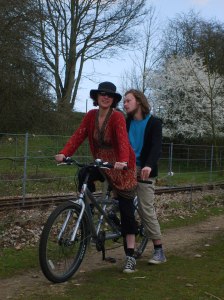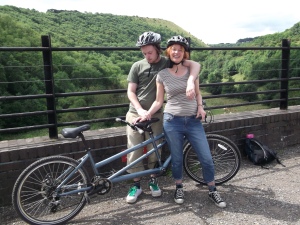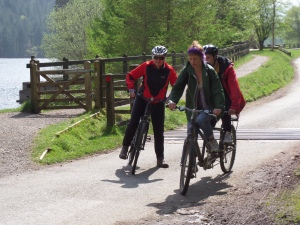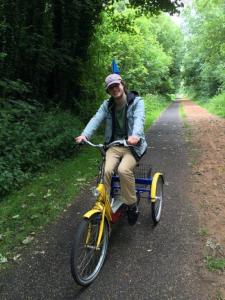
Cornwall, 2008
One of the things Dylan and I enjoy doing (which is perhaps obvious from our blog photo) is tandem cycling. I will not forget our first time. We were on holiday in Cornwall in the summer of 2008 so Dylan would have been 14. Our holiday cottage was close to a cycle hire on Cornwall’s coast-to-coast trail and all week, as we drove by on our way elsewhere, I found myself hankering after a bike ride. ‘If your brother wasn’t autistic’, I told my daughter, ‘we could do that.’
There are some things which aren’t possible with an autistic child in the family. Mostly I try not to represent this within a deficit framework, as a loss, but focus instead on the opportunities which Dylan’s interests allow – rides on steam trains for example. Sometimes, though, my daughter or I would sound a note of frustration at perceived obstacles. On summer holidays, in particular, we seemed to be presented with opportunities which didn’t feel like an option for us. So every day on that holiday in Cornwall, as we drove by the cycle hire, I rehearsed the reasons it wasn’t possible.
Dylan wouldn’t be able to balance. He had no awareness of people or traffic so wouldn’t be able to steer. Even if he managed to stay on and avoid other cyclists he wouldn’t know how to brake. He would fall off and hurt himself. And he wouldn’t wear a helmet. He could be seriously hurt. No, it was out of the question. ‘We could get a tandem mum’ my daughter retorted.
While being on holiday with an autistic child can bring to mind all the things that aren’t possible, equally they can stimulate a certain courage. Everyday routines may be enabling when you are living with autism but they can also be limiting; holidays can be like lifting a sash window after rain and letting it stand open just a little. ‘No way’, I replied: ‘we’d both end up in the hospital. Your brother is heavy. And he’s taller than me. No way’. But all week that window stayed cracked open. And each day, as we drove past, we could feel the air on our faces.
*

Norfolk, 2010
On the day before we were due to leave I said Yes. In my memory it has remained one of the most joyous days of my life. I remember chatting to the cycle hire lad, explaining the situation and hoping to be talked out of it. There was something encouraging about his nonchalance; he had no doubt that I would be able to manage. He showed us to a car park and told us to practice a little; if we changed our minds that was fine. But oh the exhilaration as I managed the first few yards. The excitement was overlaid by apprehension as we wobbled along the trail later that day but the main feeling I remember is happiness.
Since then, tandem cycling has been a regular activity. I tried Dylan on a solo bike once, in an empty car park, to see if he could manage but he became distressed. Dylan wasn’t comfortable or confident and that’s fair enough; I need to trust his evaluation of his own limitations sometimes. And in any case, tandem cycling has all sorts of benefits. It helps develop Dylan’s coordination, for example, and his trust in somebody else. He also learns to work in partnership and to understand the importance of team work. Perhaps one of the most significant benefits, however, is that tandem cycling requires us to develop alternative ways of communicating.

Monsal Trail, 2012
Because I have my back to Dylan on a tandem we can’t use the non-verbal strategies we usually do. So, for example, if we approach a junction I can’t point left then right and ask ‘which way, Dylan?’ because I can’t see his answering point. Dylan doesn’t understand the abstract ‘left’ and ‘right’ so I can’t ask a straight question. What to do? I could make the decision for us but that takes away Dylan’s participation. I could stop at each junction so we can use non-verbal communication but that means a stop-go ride (not great on a tandem). So what we have developed instead is a system of vocal response to gesture, something I hope will encourage Dylan’s use of language off the tandem as well as on it (by increasing his understanding of ‘yes’ and ‘no’ for example).

Derwent Water, 2014
For me, then, the greatest gift of tandem cycling is that it is a shared practice which requires the social use of language. Dylan doesn’t simply have to pedal; he has to communicate with me so that we do it together. Dylan’s limited core vocabulary includes the expression ‘pedal ready’, which he responds to perfectly, spinning his pedal to midnight to bear down on it in time with me: ‘One, two, three, push Dylan’. Dylan’s balance is marvellous and he sits impeccably on the back, responding to an increasing repertoire of commands and instructions: ‘Duck Dylan’ if a tree branch lours too close to my head or ‘Bumps ahead’ if I spot sleeping policemen on the trail. He can, it’s true, be a bit of a slacker at times: ‘Push Dylan’ I shout ‘come on, push’. Sometimes I take my own feet off the pedals to encourage him to put his back into it – and when he does it’s like a sudden wind at mine.
*

Clumber Park, 2015
Our home city (sometimes referred to as The Rome of England) lies in the bowl of seven hills. You have to be fit to cycle here; whether I turn left or right from my front door within five minutes I have hit a gradient to raise the heart’s beat. Of course the serious athletes and cyclists love it; high-viz vests jog and glide by my window in a constant stream from 5am till midnight. But it’s not so great on a tandem when you are at the front and the man on the back is over 11 stones and not pulling his weight.
Tandem cycling has always been something we do on holidays, therefore, and on the more manageable trails which criss-cross the nearby Peak District and skirt the lakes and reservoirs. Although I’d love to own a tandem I cannot imagine lifting and securing one on a car roof rack by myself. So instead we hire them when we need to and, since that first ride in Cornwall, have enjoyed fabulous cycling across the country and locally. So last weekend, hankering after a bike ride, I planned a trip to one of our favourite places.
‘It’s exactly a year since we went to Clumber’ I told Dylan on the drive there. I knew that because earlier in the week I’d commented to a friend that the Honesty I’d bought at Clumber Park that day had done spectacularly well in my garden. ‘In fact’, I said to Dylan, ‘I think that might be the last time we went cycling’. I fell silent. I’d realised that it was approaching a year since Dylan moved to residential care. For whatever reason, adjusting to new patterns of contact seemed to have meant less cycling. Then I remembered something: ‘But you’ve been cycling haven’t you?’ I said: ‘Just not on the tandem with mummy’. Dylan was silent; he stared, inscrutable, through the car window.
*

Weir Therapy
At the cycle hire all seemed well. It had been raining a little so it was quiet and there were plenty of tandems available. I decided to book one out for the whole day rather than our usual two hours: we had a picnic with us and it was still early enough to explore as well as ride our usual route. Within five minutes of setting off, however, it was clear that something was wrong. Dylan started chanting ‘hego, hego, hego’ (i.e. here we go), not in the excited way he announces the start of something he is looking forward to but repeatedly, meaning ‘I’m not comfortable with this, please stop’. A moment later, the tandem wobbled and juddered as Dylan put his feet to the ground (something he has never done in all our years of cycling). I pulled up. ‘What’s wrong Dylan?’ I asked. ‘What is it?’ He couldn’t tell me, of course. And I couldn’t figure it.

Time to read a couple of poems…
I set off again but the chanting began instantly and, as we cycled downhill towards the bridge over the lake, Dylan scraped his feet on the ground shouting ‘oops, oops’ (meaning ‘I’m scared of falling’). I had never known Dylan like this. Unsure what to do I suggested we wheel the bike along the path. This seemed to calm Dylan so after a while I indicated to get back on. But Dylan was clearly still uncomfortable on the tandem; half way around the lake, a distance from the cycle hire and very close to water, the last thing I wanted was for Dylan to have a full-blown anxiety attack.
For the next hour I took things slowly. We walked quite a lot. We cycled short stretches. I chatted to Dylan while we were cycling to try and distract him from whatever thoughts were intruding. I got us back on the safest and most familiar routes of all the ones we have ever taken in the park. And I headed for the weir which Dylan loves to watch. The water seemed to calm him a little but when we set off again, heading away from the lake and onto a short section of road, Dylan put his foot down. He really did not want to cycle through the approaching gateway.

This is wider than the gate we had fallen at but still enough to make Dylan nervous.
Then I had a memory. The last time we had cycled in the park I had misjudged the gap between a similar set of gateposts and, for the first and only time in our tandem-riding experience, we took a tumble. It wasn’t a serious spill; we were going at a sedate pace and I took the brunt of the fall and managed to hold the falling bike against me so that Dylan more or less stayed on. But it had shocked him and he had said ‘oops’ repeatedly as we made our way back to the cycle hire that day. Was that why Dylan seemed so nervous today? Was this now his overwhelming tandem memory?
Once I had made the connection I could sense Dylan’s agitation increasing as we approached the junctions to gated trails. I made a point of dismounting and pushing the tandem through instead of riding. Slowing to dismount in good time seemed to calm Dylan. Stopping for a picnic also seemed to help 🙂 Dylan wasn’t completely restored though; he wanted to return the tandem after we had eaten rather than head off again. I persisted gently, building in lots of choice and stops at junctions as well as a detour to look at a ford in the road which Dylan hadn’t encountered before.

Transpennine Trail, 2015
I wouldn’t say Dylan was at ease on the tandem but he was certainly more relaxed. ‘Shall we head back’ I said to Dylan, thinking I should end the day while it was good, ‘and have a drink in the cafe?’ At the cycle hire people were returning their bikes in good time. One family walked by with a trike triggering me to exclaim: ‘Look Dylan – a trike like the one you rode with [naming staff at his residential setting]’. Dylan pulled away anxiously, covering his ears and moaning. ‘It’s alright’, I reassured him, ‘we’re not hiring one now. Mummy was just remembering something’ (I have been working on ‘remember’ with Dylan recently).
I had been astonished, last summer, when a photo of Dylan on a trike pinged into my inbox. I knew cycling on the Transpennine trail was on Dylan’s programme for that day but I’d expected him to be on the back of a tandem. I hadn’t ever hired a trike because, as far as I was concerned, it wasn’t balancing that was the issue for Dylan but being in sole control. I had spent years riding tandem with Dylan because I thought he couldn’t steer or brake. Had I got things so wrong? I was delighted at this apparent development but somewhat incredulous. Later I discovered that shortly after the photo was taken Dylan had steered the trike off the trail and taken a tumble. Twice. ‘Why wasn’t he on a tandem?’ I asked. Apparently the staff supporting Dylan that day didn’t feel confident enough to ride one. While I understood this, I didn’t understand the decision to hire a trike instead: ‘Do you want to leave the cycling for now’ I said to the care home manager ‘and I’ll take Dylan at weekends instead’.
Except I hadn’t managed it since, I thought to myself, as we handed our helmets back to the cycle hire. Dylan was pulling at me, wanting to get away from the trike: ‘Oops’ he said: ‘oops, oops’. Could this be what he was remembering as well? Not just the spill from the tandem but the tumble from the trike? Dylan dislikes falling; if his previous two experiences of cycling had involved a fall, no wonder he had been reluctant. I was reminded, once again, of how powerful Dylan’s memory is but also of how quickly he loses confidence. ‘There’s a saying’, I said to Dylan as we sat with our drinks in the cafe, ‘that when you fall off a bike you get back on again. Well done today. We’ll come back again soon’.









Brilliant account. I loved every minute of it. x
LikeLiked by 1 person
Thank you Nell, x
LikeLike
Thanks for sharing Liz. I couldn’t stop reading till I got to the very end. You are a strong woman and I admire you. I pray that the good Lord will continue to keep you, Dylan and your daughter.
LikeLiked by 1 person
Why thank you Moe – I appreciate that, x
LikeLike
Once again, a great post with wonderful pictures. I could feel myself with you in those adventures, Liz. Keep walking (tanding)!
🙂
Best regards
Eder
LikeLiked by 1 person
🙂 Thank you for reading!
LikeLike
A friend who spent his working life living amongst people with Autism told me that he felt that often their memory was so acute that it became a problem. He felt that it was almost as if all their experiences were constantly present to them. What he meant was that whereas I might seek for something in my memory, some of his Autistic companions never had to ‘seek’ – their memory invoked by any particular circumstance was instant. Whereas retrieving a memory might be difficult for me, for someone with autism the difficulty was forgetting.
Like Dylan many of my friend’s companions had either limited or no verbal skills. My friend came to this perception through observation of behaviours.
For me it is always life-enhancing to read your blog – to see the reality of your love for Dylan through your constant seeking to understand him and meet his needs.
LikeLiked by 1 person
Hi Tom – good to hear from you. The view of your friend makes perfect sense to me. I could quite believe this is true of Dylan too. Your phrase ‘whereas retrieving a memory might be difficult for me, for someone with autism the difficulty was forgetting’ feels like a poem. Thank you! Thank you, also, for your nice comment about my blog. Liz
LikeLike
Looks nice 🙂
LikeLiked by 1 person